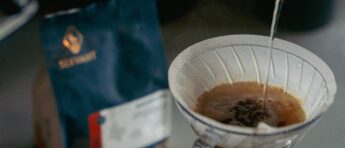How to Get the Most from Your Home Espresso Machine
- Espresso
- June 26, 2024
If you want to make coffee shop quality espresso at home, then you need to “dial in” your espresso machine every time you use a new coffee. “Dialing in” is just a fancy way to describe the process of calibrating your machine so that it brews in a way that gets optimal extraction from whatever coffee beans you’re using. In this article, I’m going to explain, step by step, how to do this.
What You’ll Need
Aside from an espresso machine and whole coffee beans, you’ll need three pieces of equipment to dial in your machine. These are:
- A grinder that can grind finely enough for espresso (the Baratza Encore Grinder is the most affordable grinder of this type on the market right now.)
- A scale that can measure to the nearest 0.1 gram and which is slim enough to fit under your cup during brewing (our recommendation is the Acaia Pearl Digital Scale as it has less than 20 ms of latency.)
- A timer. The Acaia Pearl Digital Scale already has a built-in timer, so if you have this then you have no need for an additional timer.
Step 1: Weigh Your Empty Portafilter and then Zero Out Your Scale
One important variable when dialing in your espresso machine is dose – meaning the amount of ground coffee that you’re brewing with. You’re going to want to know your dose’s weight, but you don’t want to put ground coffee directly onto your scale as this is just going to make a mess and waste coffee. So, you first want to put your portafilter (the detachable part of your coffee machine where your ground coffee sits during brewing) on your scale and then zero off your scale. This means that you can then put your loaded portafilter back onto your scale to find out the weight of the ground coffee you’re brewing with.
Step 2: Make Sure You’re Grinding the Correct Amount of Coffee
The “correct” amount of coffee to brew with depends on your portafilter and (more specifically) portafilter basket. You want it so that there is 2mm of space between the top of your ground coffee puck and the top of your portafilter basket after you’ve tamped. This gap is called “headspace”. Too little headspace means that you’re mashing ground coffee into your machine’s showerhead when you brew. Too much headspace means that water will pool on top of your puck during brewing. Both of these can cause channeling which will result in sour and harsh notes going into your shot. A mistake that I see a lot of people making is that they base their dose purely on weight.
While your dose’s weight is important to know (I’ll explain why in just a minute), it shouldn’t be something that you specifically aim for when dialing in your espresso machine. This is because keeping a fixed dose but changing your grind size will affect the amount of headspace you have. Finer ground coffee can be compacted more tightly than coarser ground coffee, so the latter will leave you with less headspace even if their mass is the same. So, to reiterate, you want to use enough coffee so that there’s 2 mm of space between the top of your tamped puck and the top of your portafilter basket (regardless of how much this weighs).
This will take a few attempts to master, but once you have achieved it then you should be able to just keep your grinder’s settings constant, so it outputs the correct amount of ground each time. It doesn’t really matter what grind setting you use here, if your grinder has a demarcated “espresso range” then just put it in around the middle of this range.
Step 3: Weigh Out Your Ground Coffee
Once you’ve filled your portafilter and have the correct amount of headspace, you then want to weigh how much ground coffee you’re brewing with. Just put your loaded portafilter back on your zeroed out scale and take note of how much this weighs. Most double shot portafilter baskets are designed to hold around 18-19 grams of ground coffee while keeping this 2mm of headspace.
Step 4: Brew Your Shot While Keeping Track of Your Shot Time and Brew Ratio
Attach your portafilter to your machine, put a scale under your cup, press brew and start your timer. You want to keep your eye on two variables when you do this:
- The mass of liquid espresso going into your cup: Espresso generally works best with a brew ratio of 1:2.5. This means that you want the volume of liquid in your cup to be 2.5 times the mass of ground coffee you brew with. So, for example, if you’re brewing with 18 grams of ground coffee then you want around 45 grams of liquid in your cup at the end. This is why it’s important to know your ground coffee’s weight before your brew.
- How long your shot takes to pull: You want your shot to pull in 25 – 35 seconds from when you first press brew to when you hit that 1:2.5 ratio in your cup.
While each coffee bean has its own ideal brew ratio and brewing time, a 1:2.5 ratio in 25 – 30 seconds should get you a good tasting espresso with most beans. If your shot takes shorter than 25 seconds to pull, then you will need to grind finer. If it takes longer than 35 seconds to pull, then you need to grind coarser. Once you hit this 1:2.5 brew ratio and 25 – 35 second brew time then you’re in the right ballpark with your grind size and it’s time to start tasting and tweaking.
Step 5: Tasting and Tweaking
With this aforementioned brew ratio and brew time, you’ll likely have an espresso that’s at worst perfectly drinkable and at best absolutely delicious. If you’re closer to the “drinkable but not perfect” side of things, then it’s time to start playing around with grind size. Grind size affects extraction rates. The finer your coffee is ground, the more of your coffee’s surface area is directly exposed to your brewing water so the faster it will extract.
This means that grind size will affect your espresso’s taste in the following ways:
- Grinding finer will reduce the amount of sharp notes in your espresso: So if your espresso makes your mouth pucker then try grinding finer.
- Grinding coarser will reduce harsher bitter notes in your espresso: If you need to drink water immediately after your shot then you probably want to grind coarser.
Bear in mind that adjusting flavor through changing grind size works best if you keep your brew ratio constant. So, you’ll want to keep brewing with a scale under your cup until you’ve completed this dialing in process (many home espresso machines have automatic volume dosing so you can save shot volume sizes).
How Often Do I Need to Dial in My Espresso Machine?
I’d recommend that you redo this dialling in process whenever you switch up your coffee beans. You can usually get away with keeping your machine and grinder settings the same so long as you’re using the same bean origin, however perfectionists will want to dial in from bag to bag to accommodate for slight differences in roasting.
What if I Don’t Have a Coffee Grinder?
If you don’t have a coffee grinder that can grind finely enough for espresso, then you can’t really dial in your espresso machine. You can still make decent espresso with pre-ground coffee, but you want to make sure that you do three things:
- Buy good quality coffee beans, ideally specialty coffee.
- Ask your roaster to grind your beans specifically for espresso.
- Brew with a pressurized portafilter basket. This adds extra resistance to your brewing water and ensures that your shot pulls in around 25-30 seconds, regardless of grind size.
Pressurized portafilter baskets have one hole in their bottom compared to non-pressurized basket’s hundreds of holes. Brewing like this won’t get you as good an espresso as brewing with freshly ground coffee, but it will still be a decent stop gap until you get your hands on an espresso grinder.
Wrapping Up
To get the best out of your espresso machine you want to make sure that you’re brewing at a ground coffee to liquid espresso ratio of around 1:2.5 and that your shot pulls in 25-35 seconds. Using this as a baseline, you can then use grind size to fine tune your espresso’s flavor. Each bean varietal has its own flavor profile, so you’ll want to recalibrate your machine and grinder every time you change up your beans. If you’re interested in brewing espresso with high quality coffee, then check out our selection of specialty coffee beans.
This article was written by Oli Baise. Oli is a barista who writes about all things coffee at his site Drinky Coffee.

